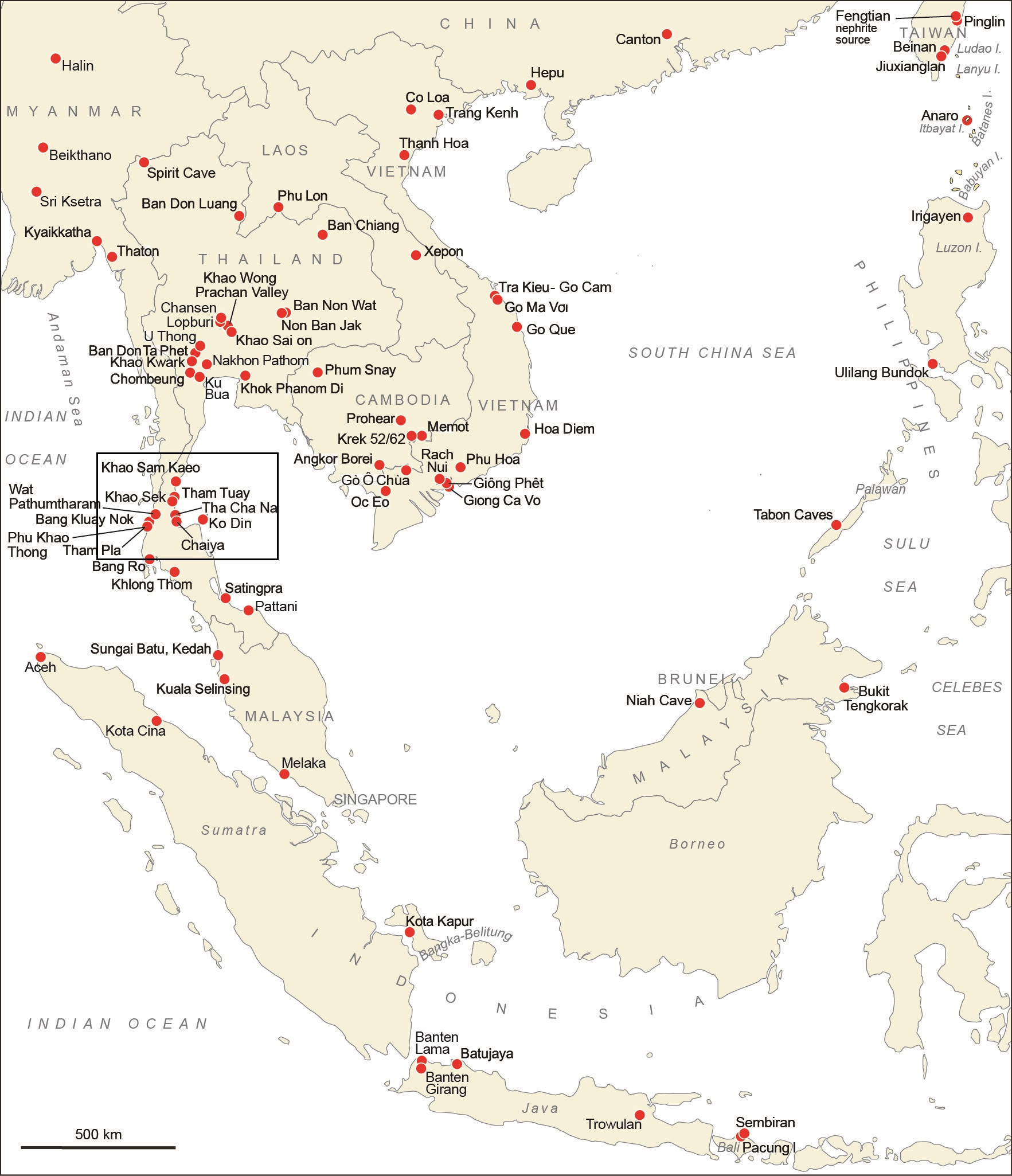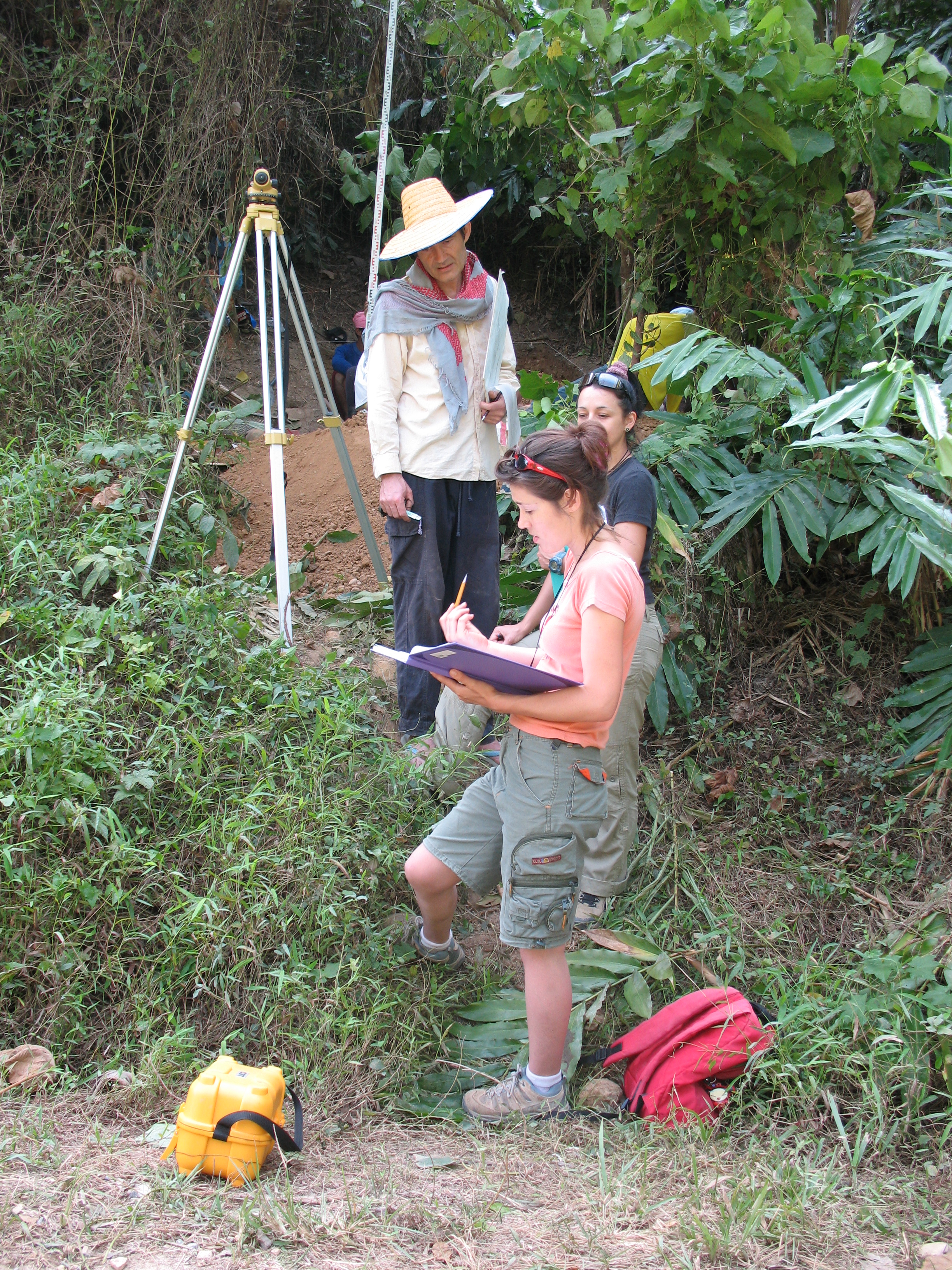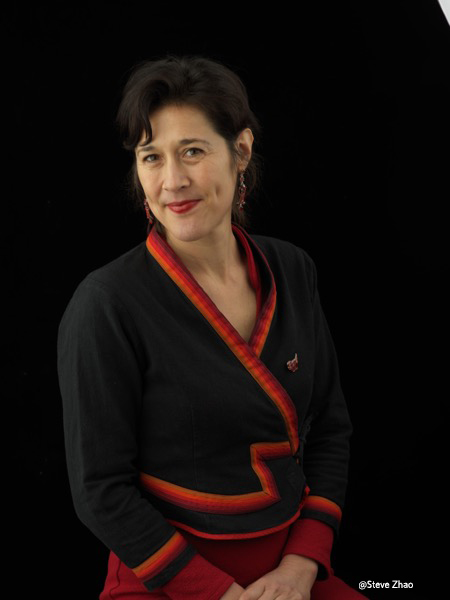早期海上丝绸之路的全球化:克拉地峡系统和多元的历史
Globalisation along the early Maritime Silk Road: A view towards a systemic and plural history from the Isthmus of Kra
贝纳妮丝·蓓琳娜 Bérénice Bellina
(法国国家科学研究中心 French National Centre for Scientific Research)
导言
以布劳岱尔作参考框架,并受“全球研究”与“连接历史”作品的影响,本研究关注孟加拉湾(Bay of Bengal)与南中国海长期的文化交流,该古老的全球化过程传统上以“印度化”称之,相当于海上丝绸之路东段。泰马半岛是一片介于这两个海洋盆地之间的狭长陆地,而克拉地峡则位于其上部和最狭窄之处。纵贯半岛的他念他翁山脉(半岛北部多座2000公尺以上的高山),被河水沿坡而下的河谷打断,部分组成了所谓的“跨半岛路径”。尽管历史上两岸都出现过港口,历史学家并不认为这些路径跨越了不同的环境(海洋、河口、平原和森林),而是要求结合不同的运输方式作为贸易路线的重要选择。

本研究是法国与泰国联合的考古项目,地点在泰国半岛上的克拉地峡,自2005年起和代表曼谷泰国艺术大学的Praon Silapanth 与Rasmi Shoocongdej教授合作。2017年开始,该项目演变为法国在泰国与缅甸的考古项目,并纳入缅甸考古部门和曼德勒大学为新的合作伙伴,分别由U Maung San Win (Dawei Branch)和Kalayar Myet Myet Htwe代表。
研究聚焦于公元前第一个千年到公元前几个世纪之间的跨文化交流过程。考古团队采纳产业的技术方法 (技术人类学的一个领域),来描绘每个群体的社会技术系统。该项目也发展了区域性的考古工作,发掘和调查位于相异环境(沿海、红树林、近海岛屿和森林内陆)、类型不同的遗址(洞穴、开放聚落、中转站)。目标是研究不同技术群体的空间分布,以建立半岛上各社会群体的文化序列、社会组织和当地与区域间的互动。藉由这样的方法,我们旨在研究出现在半岛上(包括当地与外来的)不同社会群体之间的共同演化,以及他们身处的地域环境在跨区域交换网络之间的关系。此外,这些群体如何贡献于区域的历史轨迹也是研究目标。
成果–公元前最后数世纪社会经济组织的综合报告
本项目发掘和调查36个遗址,揭示了半岛上一系列复杂的阶层网络,以及包含多个社会群体的专业化遗址。这个复杂的网络让部分的早期城邦国家成为区域的文化摇篮。公元前5世纪晚期到4世纪早期,像Khao Sam Kaeo这样的区域性贸易港口,从公元前第一千年纪、至今仍认识不足的早期区域网络发展而来。从公元前3世纪到1世纪,交换网络上的活动明显增加,且属于不同环境的当地和外来族群在文化和经济上界定更明显,全都一起构建了复杂的跨区域文化,或可将之称为全球文化。
1.公元前4世纪:复杂港口聚落与邻近腹地的出现
在公元前5世纪末或4世纪初,作为区域经济和文化中心的当地港口聚落出现,包括东岸的Khao Sam Kaeo与Khao Sek以及西岸的Phu Khao Thong。它们已经展现了复杂的都市、政治和经济组织发展的样式;不只汇聚了来自南亚和南中国海东部等大范围区域的舶来品,也有兴盛的作坊。这些制造的产品具有被称为“南中国海史前晚期”的跨区域风格,结合外来的原料和熟练的技术(经常是印度式的),有时还会由外来匠师主导。从泰国到菲律宾,这些物品在当地的和区域的层级进行再分配。此种风格证实了低地群体在公元前一千年纪中叶已前往孟加拉国湾,以及南中国海活动(近期越来越多考古证据强烈支持)。

上述物品的一个主要生产中心在Khao Sam Kaeo (2005-2009),一个年代介于公元前5世纪末到前1或2世纪的城市综合体,距离东海岸8公里,掌控着一条跨越半岛的贸易路线。Khao Sam Kae有着外来社群,住在被路堤划分出来的都市区域,其占地严格说起来延伸超过35公顷,位于平行的双重简单土墙之间,土墙上可能有木栅栏。水利系统提供了一个停泊处(河谷1),且能储存水源,可能具有农业目的(河谷2)。干栏式住屋和梯田构成的网络相当浓密,不断积累的纪念性或家户的梯田和水道为其特色。
经空间分析清楚界定出来两个范围:一相当于山丘1和2的南部区域,是当地居民和少数外来工匠原本使用的核心,其特征是“南中国海史前晚期”早段类型的物质文化。自公元前4世纪初,使用进口原料与外来风格或技法的物品在此被加工。更北部的山丘3和山丘4,则和较晚期的聚落扩张有关(见以下我们的分期2),里面有外来商人和工匠组成的社群。后者的标志为印度式精致器皿、冶炼高锡青铜的坩锅、越南北部与汉代中国器物的出现。在进口更多成品的同时,许多器物仍持续在当地以外来技术生产,例如高锡青铜碗。这些当地制造的器物属于“南中国海史前晚期”的较晚段,饰品和陶器显示此时其包含更多适应南亚的产品。
Khao Sam Kaeo是东南亚目前最早的复杂都会政治实体,极有可能是早期的港口城市。藉由数世纪的兴建、改造和维持纪念性建筑、环绕的城墙、护城河和水利系统,产生了一定程度的权威,能够掌控相当的建设劳动力,以及一套延续数代的政治宣传,用来执行建物的日常维护。它复杂的经济组织透过农业生产支持,维系着各种活动。除了纪念性建筑的证据,遗址内部的配置也指向社会政治的复杂性,特别是社会专业化的不同区域对应不同的社会群体和活动。手工业活动依赖远程的供应和分配网络(玻璃和硬宝石就是一个很好的例子)并牵涉异域的专家。
本研究从详尽阐释东南亚都市空间得到启发,建议要结合区域发展、大陆东南亚地区常见的环濠聚落传统和外来输入。至于Khao Sam Kaeo,在区域模型之外,时代介于公元前第一千年纪初期到中期、属于“第二次都市化”的东南亚城墙城市,也可能作为一个参照来源,特别是当考虑到两者之间在类型、位置、大小和城墙系统的相似。
位于Khao Sam Kaeo以南80公里的港口聚落Khao Sek,虽然相对小型且较不复杂,也没有出现围墙和大都会的迹象,仍显示是建立在和Khao Sam Kaeo相似的模型之上。然而Khao Sek和Khao Sam Kaeo两者的技术系统难以区分,都以同样高度熟练的混合手工业为特征并同时演变。比较这些遗址和技术系统描绘出一个复杂的政治结构,是由同时期彼此互补的专业化城市国家形成一个阶序的联盟。Khao Sek掌控另一个跨半岛路线的出口,链接克拉巴厘(Kraburi)区域。从这个遗址没有外来社群存在的证据,这进一步证明Khao Sam Kaeo充当了国际市场。此联盟似乎能跨越数个河谷盆地,并透过结盟其他港口聚落取得更大的腹地,可能延伸到邻近的海洋盆地。这个政治结构展现和马来港口城市部分相应之处,后者采用上下游分层以及P.-Y.Manguin所描述室利佛逝(Srivijaya)使用的“曼荼罗类型(mandala type)”的两种模式上组织起来。在这样的背景下,Khao Sek将是Khao Sam Kaeo边陲的一部分。
直到今日只有透过丧葬堆积中的宝石、玻璃珠宝和发现于邻近洞穴来自区域产业港口的复杂陶器,才能看到周围地区的人群。这些区域港口本身和它们邻近腹地的交换,可能根基于农业收成的交换。稻米和小米构成Khao Sam Kaeo的农业基础,Khao Sek可能也是如此。(Castillo, 2017)与腹地联系的其他间接证据在于当地锡的开采,青铜工艺品的生产分析证明了这一点。
2. 更多文化和经济群体间,基于复杂合作关系的交换增加
从公元前3世纪到1世纪甚至更晚,交换随着专业化遗址(如转运站)的出现而增加。当在地群体在经济上与文化上越能清楚界定,越来越多的人群出现在半岛上,有的在港口聚落,其他则在河口和邻近岛屿,或许可诠释为早期的水上人家。在此第二时期,属于岛屿、港湾、河口和内陆等不同环境的相异文化群体,全被连结在一起并和谐工作。
在这个较晚的时段,更多的港口聚落被辨识出来:泰国西岸的Phu Khao Thong-Ban Kluay Nok,缅甸南部的Maliwan以及可能的Aw Gyi,那里发现更多的外来群体和进口物品,部分可能和西方世界有关。此时期可能也是Khao Sam Kaeo势力向北延伸,且新的围墙在新建筑群周边盖起的时期。港口聚落富含的广域物质文化,暗示存在更多的社会群体,包括从汉代中国、南亚的进口物品,也有从南中国海域、菲律宾和台湾来的材料。
在此时期,一连串内陆遗址沿着主要和次要跨半岛路径出现。丹那沙林中央山脉中的洞穴被当作临时营地使用,也作为丧葬用地,出土从区域港口聚落输入的宝石和玻璃饰品。也有位于河川支流的露天转运和集货遗址,一般沿河流水系等间隔分布,提供有关长途贸易网络的考古学遗存,如源自越南北部或中国南部的铜鼓(Dong Son Drum)、玻璃珠和外来陶器(印度式精致器皿)。这类遗址包括沿着朗逊河(Langsuan,春蓬府Chumphon)的Ban Na Hyan 和Pangwan,以及在较小的撒维河 (春蓬府)畔的Tham Nam Lot。这些内陆遗址构成先前缺失的关键证据,支持跨半岛路线的存在。
从此时期开始,半岛上出现和南中国海与菲律宾关系特别密切的外来群体。这些人群一部分被我们视为早期水上人家,在河口非常活跃,并主导上游和下游之间的贸易。另一部分则在港口定居,作为港口聚落和上下游/跨半岛路径网络之间的中介点,在战略位置上变得重要;他们的物质文化证实他们参与跨区域网络与在地的上下游交换网络。比较来自泰国马来半岛和菲律宾的Sa Huynh-Kalanay相关陶器研究,显示这些使用沿海和近海洞穴的群体也和菲律宾有反复的接触。
结论
我透过“共同建构”的视角,提出关于文化过程的想象模型,即多元组织的群体联盟起来,构成港口城镇和其腹地的网络,并在一段时间后渐渐连结到更大的、跨越两个海洋盆地的区域。这个架构能解释跨区域风格的扩张,其混合的特质是这个扩展政治结构中不同的群体所共同创造。集中化结构的出现也让文化差异和经济专业化更加具体。在所有关注的人群之中,最早的水上人家,部分常被视作边缘群体,却在这个网络中扮演经济上和文化上重要的中介角色。此模型较平衡地呈现关于交换和全球化整体的文化过程,超越核心和边陲,描绘一个快速布局的动态网络,包含一连串活跃的、忠诚浮动的中介者,并在经济和文化中扮演活跃的角色。
作者介绍
贝伦妮斯·蓓琳娜博士是研究南亚和东南亚的考古学者,法国国家科学研究院的资深研究员。她的研究专注于海上丝绸之路,特别是南亚和东南亚之间的交流和文化变迁过程。她以产业的技术分析作为认识社会政治过程的方法,用以建构远程交换与开采当地资源对族群和认同建构的冲击。2005年她与曼谷泰国艺术大学共同创立在上部泰国马来半岛的泰—法联合考古项目。从2017开始,她与缅甸考古部门(缅甸宗教事务与文化局,一起主持泰缅半岛的考古计划。来自世界各地的学生和研究者参与到该项目中,目的是发展一套有关区域交换的系统性方法,研究不同人群和生态系统,从公元前第一千年纪早中期到公元后第一千年纪晚期远距离交流过程中的共同演变。从中她努力阐述一套关于水上人家等过去所称为“边缘群体”的考古学,用长时段的视角来研究他们的历史。她也对文化遗产感兴趣,特别关注现在对于过去的表征和使用,特别是东南亚海上丝绸之路的遗存,这样的兴趣催生了当地社群参与遗产化过程。她的研究结合考古、考古科学,纳入历史、博物馆、社会人类学和技术研究。
Introduction
Taking Braudel as a frame of reference and inspired by “Global studies” and “Connected History” works, the research summarized here concerns the long-lasting cultural exchange process between the Bay of Bengal and the South China Sea, an ancient globalization traditionally called “Indianisation”, also corresponding to the eastern part of the “Maritime Silk Road”. The Thai-Malay peninsula is a long stretch of land between these two maritime basins and the Isthmus of Kra is located in its upper and narrowest part. Running along the peninsula, the chain of Tenasserim (mountains up to 2000m height in the northern part of the peninsula) is punctuated by valleys whose rivers flow along its slope, some of which constitute passages called “transpeninsular routes”. Despite the presence of historical ports on both coasts, historians did not consider these tracks traversing different environments (marine, estuarine, plains, and forests) and requiring various modes of transport as serious candidates as trade routes.
Research was conducted in the Isthmus of Kra by the French-Thai Archaeological Mission in peninsular Thailand, a collaboration with Silpakorn University (Bangkok) represented by Praon Silapanth and prof. Rasmi Shoocongdej from 2005. From 2017, the mission evolved into the French Archaeological Mission in peninsular Thailand-Myanmar with the Department of Archaeology and the university of Mandalay as new partners respectively represented by U Maung San Win (Dawei Branch) and Kalayar Myet Myet Htwe.
The research focuses on the inception and process of cross-cultural exchange during the first millennium BCE and until the early centuries CE. The Archaeological Mission’s team implements the Technological Approach (a field of Anthropology of Technics) of industries to characterise each group’s socio-technological system. The Mission also develops a regional archaeology by excavating and surveying different types of sites (caves, open-air settlements, relay stations) from different environments (coastal, mangrove, offshore islands and forested inland).
The objectives are to study the spatial distribution of the different technological groups, to generate a cultural sequence of the social groups in the peninsula, and to study their organisation and local and regional interactions. By doing so, we aim at studying the co-evolution of the different groups present in the peninsula (local and exogenous) and their environment in relation to the region’s insertion into inter-regional exchange networks. Additionally, the aim is also to determine how each of these groups contributed to the regional historical trajectory.
Results – Synthesis on the socio-economic organisation during the last centuries BCE
The mission excavated and surveyed 36 sites unraveling a sequence of a complex network of hierarchic and specialised sites involving various social groups present in the peninsula. This complex network formed part of incipient city-states acting as regional cultural cradles. From the late 5th-early 4th c. BCE regional ports-of-trade such as Khao Sam Kaeo develop out of the still poorly known early first millennium BCE early regional networks. From the 3rd c. to the 1st c. BCE, activity within exchange networks clearly increases and local and exogenous groups belonging to different environments appear economically and culturally better defined and area all working in concert and contributing to elaborate a pan-regional culture or what one may want to call global culture.
1. The emergence of complex port-settlements and their immediate hinterland- 4th c. BCE
In the course of the late 5th c. or the early 4th c. BCE, local port-settlements acting as regional economic and cultural centres emerged, such as at Khao Sam Kaeo and Khao Sek on the eastern coast and Phu Khao Thong on the western coast. They already display the development of complex urban and political models and of an elaborate economic organisation. They not only concentrate large ranges of imports from South Asia and the eastern part of the South China Sea but also had active workshops. Those manufactured products of a pan-regional style I called “Late Prehistorical South China Sea style” that combined foreign raw materials and skilled techniques (often Indian) sometimes under the aegis of foreign artisans. These goods were redistributed at local and regional levels from Thailand to the Philippines. This style attests to the already well-established maritime orientation of lowland groups towards both the Bay of Bengal and more strongly (i.e. currently supported by more archaeological evidence) towards the South China Sea by the mid-first millennium BCE.
A major centre for their production is Khao Sam Kaeo (investigated 2005 -2009), an urban complex dated to the late fifth to second/first centuries BCE. Commanding a transpeninsular trade route, it was located 8km from the eastern coast. It hosted foreign communities who lived within urban quarters demarcated by embankments. Its occupation stricto sensu extended over 35ha within simple and twin parallel earth walls that were probably surmounted by wooden palisades. A hydraulic system created a mooring place (valley 1), and to retain water, possibly for agricultural purposes (valley 2). The network of habitations on piles and terraces was dense and characterized by accumulations of monumental and domestic terraces and drains.
Two clearly defined zones emerged from the spatial analysis: a southern area corresponding to Hills 1 and 2, the initial core used by local populations and a few foreign artisans characterised by the early “Late Prehistoric South China Sea style” type of material culture. From the early 4th c. BCE, materials were locally worked using imported raw materials and exogenous styles or techniques. Further north, on Hills 3 and 4 corresponding to a later expansion of the settlement (see below our Period 2), there were communities of foreign merchants and artisans. The latter were indicated by the presence of Indian Fine Wares, crucibles for high-tin bronze metallurgy, and northern Vietnam and Han Chinese material. More finished objects were imported whilst others were kept being locally produced with exogenous technologies such as high-tin bronze bowls. These locally-made artefacts belong to a later phase of “Late Prehistoric South China Sea style” that then includes more South Asian-adapted products as illustrated by ornaments and ceramics.
Khao Sam Kaeo is currently the earliest cosmopolitan complex polity of Southeast Asia. It is a serious candidate for an incipient port-city. This is supported its monumental constructions, its enclosing walls, moats and water systems that were built, transformed and maintained over centuries, thus the produce of a level of authority able to control considerable labour for their erection and a coherent political agenda implemented over several generations for their regular maintenance. Its economic organisation was also complex and sustained by an agricultural production supporting the various activities. In addition to monumental evidence, socio-political complexity is indicated by the internal organization of the site as characterized by socio-professional zones hosting different social groups and activities. Craft activities depended on far-reaching supply and distribution networks (the glass and hard stone industries are a good examples) and involve foreign specialists.
The sources of inspiration for the elaboration of urban spaces in Southeast Asia suggests a combination of regional developments with the “moated-settlement tradition” found in many parts of Mainland Southeast Asia and of external inputs. Regarding Khao Sam Kaeo, besides regional models, the walled cities of South Asia dating from the ‘second urbanisation’ of the early to mid-first millennium BCE may have been a source of particular inspiration considering similarities in morphology, location, size and rampart system.
The port-settlement of Khao Sek located 80km south of Khao Sam Kaeo appears built on a similar model as Khao Sam Kaeo, though smaller and less complex, not showing signs of surrounding walls and cosmopolitanism. However, Khao Sek and Khao Sam Kaeo technical systems are identical, characterised by the same highly skilled hybrid craft industries evolving simultaneously. These sites and technological system comparisons draw a complex political structure taking the form of a confederation of hierarchically specialised and complementary city-states. Khao Sek controlled the exit of another transpeninsular route connecting with sites in the Kraburi area. There is no evidence of foreign communities at the sites, providing further arguments that Khao Sam Kaeo acted as the international market place. It seems likely that this confederation was established over several river basins, but also involved a larger hinterland of allied port-settlements perhaps reaching neighbouring sea basins. This political structure would show some parallels with Malay port-cities organized on a hybrid model of a hierarchical upstream-downstream and “mandala” type described by P.-Y. Manguin for Srivijaya. In this context, Khao Sek would be part of the periphery of Khao Sam Kaeo.
The populations living in the vicinity have until now only been visible through funerary deposits consisting of stone and glass jewellery and complex pots found in neighbouring caves coming from the regional industrial ports. Exchange between these regional ports themselves and their immediate hinterland may also have been based on the exchange of agricultural products. Rice and millet constituted the agricultural base at Khao Sam Kaeo and potentially at Khao Sek too (Castillo, 2017). Other indirect evidence for links with the hinterland lies in local tin whose exploitation is demonstrated by analysis of bronze craft production.
2. Increased exchanges based on a complex cooperation between many groups culturally and economically better defined
From the 3rd c. to the 1st c. BCE or more, exchanges increase and get organised with specialised sites emerging (such as relay/transhipment stations). Whilst local groups appear economically and culturally better defined, many more groups were then present in the peninsula, some settling in port-settlements, others at river mouths and on neighbouring islands that we interpret as early sea nomads. During this second period, culturally distinct groups belonging to the different environments; island, in ports, at river mouths and inland were connected and working in concert.
During this later period, more port-settlements are identified: Phu Khao Thong-Ban Kluay Nok complex on the western coast in Thailand, Maliwan and possibly Aw Gyi in southern Myanmar. Many more foreign groups and imports are found there, some indicating links with the Western world. This is probably the period when Khao Sam Kaeo extends further north and new surrounding walls are built around the new compounds. Port-settlements concentrate larger ranges of materials indicating the presence of many more social groups. In the latter are now found imports from Han China and from South Asia, as well as more material from the South China Sea, the Philippines and Taiwan.
During this period, a series of inland sites emerged along main and secondary transpeninsular routes. There are caves located in the Tenasserim central chain that were used as temporary camps and for funerary practices yielding ornaments in stone and glass made or imported from regional port-settlements. There also are open-air transhipment and collecting sites often localised at rivers’ tributaries. These are at roughly regular intervals along these river systems. They yield archaeological remains related to long-distance networks such as Dong Son drums from northern Vietnam or southern China, glass beads, and exogenous ceramic (Indian Fine Ware). Those include Wat Pathumtaram (Ranong), Ban Na Hyan and Pangwan along the River Langsuan (Chumphon) and Tham Nam Lot along the smaller River Sawi (Chumphon). These inland sites constitute crucial evidence that was missing before to support the use of transpeninsular routes.
From this period, exogenous groups with closer connections with the South China Sea and the Philippines in particular are present in the peninsula. Some of those groups that we interpret as early sea nomads are active at river mouths to command the upstream-downstream trade. Others settled in ports. They became prominent at these strategic locations being intermediary between ports-settlement and the upstream-downstream/transpeninsular networks. Their material culture attests to their involvement in both inter-regional networks and in local upstream-downstream exchange networks. These groups using coastal and offshore caves were in recurrent contact with the Philippines as revealed by comparative studies of the Sa Huynh-Kalanay-related pottery from the Thai-Malay Peninsula and the Philippines.
Conclusion
The model I propose envisions cultural processes through the lenses of “co-constructions” within networks of confederated port-cities and their hinterland composed of variously organized groups for a time allied in a larger connected regional space embracing the two sea basins. This structure can explain the spread of a pan-regional style whose hybrid nature was crafted by the various groups that were part of this extended political structure. The emergence of this centralised structure also crystallized cultural differentiation and economic specialization. Amongst the groups concerned, some usually referred to as marginal groups, the earliest sea nomads, emerge as key actors as economic and cultural intermediares within this network. This model offers a more balanced representation of exchanges and overall globalization processes beyond cores and peripheries. It reveals dynamic networks and configurations in which an active chain of intermediaries with fluctuating allegiances are involved and play an active economic and cultural role.
Biographical Sketch

Dr Bérénice Bellina, archaeologist of South and Southeast Asia, is Senior Researcher at the National Centre for Scientific Research. Her research focuses on exchange and cultural transfer processes on the Maritime Silk Road and more especially between South and Southeast Asia. She uses the technological analysis of industries as a means to comprehend sociopolitical processes and to reconstruct the impact of long-distance exchange and local resource acquisition on ethnicity and identity construction. In 2005, she created the Thai-French Archaeological Mission in Upper Thai-Malay Peninsula with Silpakorn University (Bangkok). And since 2017, she directs the Myanmar-French Archaeological Mission in Peninsular Thailand-Myanmar with the Department of Archaeology (Ministry of Religious Affairs and Culture of Myanmar). This programme engages students and researchers from around the world, with the aim of developing a systemic approach of regional exchanges, investigating the co-evolution of different populations and ecosystems in relation to long-distance exchanges from the early/mid first millennium BC to the late first millennium AD. As a consequence, she works at elaborating an archaeology of what have been termed “marginal groups” such as sea nomads, to investigate their history in a long-durée perspective. She also has developed an interest in heritage, with a special focus on present-day representations and uses of the past, and in particular of Maritime Silk Road remains in Southeast Asia. This interest has resulted in local communities participating in patrimonialisation projects. Her research combines archaeology, archaeological science, connected history, museology, social anthropology and technology studies.
